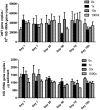Abundance and dynamics of antibiotic resistance genes and integrons in lake sediment microcosms
- PMID: 25247418
- PMCID: PMC4172728
- DOI: 10.1371/journal.pone.0108151
Abundance and dynamics of antibiotic resistance genes and integrons in lake sediment microcosms
Abstract
Antibiotic resistance in bacteria causing disease is an ever growing threat to the world. Recently, environmental bacteria have become established as important both as sources of antibiotic resistance genes and in disseminating resistance genes. Low levels of antibiotics and other pharmaceuticals are regularly released into water environments via wastewater, and the concern is that such environmental contamination may serve to create hotspots for antibiotic resistance gene selection and dissemination. In this study, microcosms were created from water and sediments gathered from a lake in Sweden only lightly affected by human activities. The microcosms were exposed to a mixture of antibiotics of varying environmentally relevant concentrations (i.e., concentrations commonly encountered in wastewaters) in order to investigate the effect of low levels of antibiotics on antibiotic resistance gene abundances and dynamics in a previously uncontaminated environment. Antibiotic concentrations were measured using liquid chromatography-tandem mass spectrometry. Abundances of seven antibiotic resistance genes and the class 1 integron integrase gene, intI1, were quantified using real-time PCR. Resistance genes sulI and ermB were quantified in the microcosm sediments with mean abundances 5 and 15 gene copies/10(6) 16S rRNA gene copies, respectively. Class 1 integrons were determined in the sediments with a mean concentration of 3.8 × 10(4) copies/106 16S rRNA gene copies. The antibiotic treatment had no observable effect on antibiotic resistance gene or integron abundances.
Conflict of interest statement
Figures


References
-
- Baquero F, Martínez JL, Cantón R (2008) Antibiotics and antibiotic resistance in water environments. Curr Opin Biotechnol 19(3): 260–265. - PubMed
-
- Pei R, Kim SC, Carlson KH, Pruden A (2006) Effect of river landscape on the sediment concentrations of antibiotics and corresponding antibiotic resistance genes (ARG). Water Res 40(12): 2427–2435. - PubMed
-
- Pruden A, Arabi M, Storteboom HN (2012) Correlation between upstream human activities and riverine antibiotic resistance genes. Environ Sci Technol 46(21): 11541–11549. - PubMed
Publication types
MeSH terms
Substances
LinkOut - more resources
Full Text Sources
Other Literature Sources
Medical

